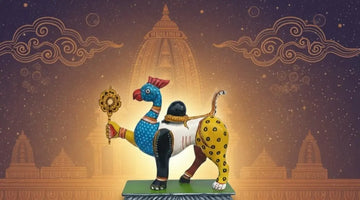Navagunjara wall art is a representation of artistic genius and spiritual depth in the constantly changing realm of home décor, where minimalism and cultural expression collide. Originating from Odisha's sacred mythology and preserved through the centuries-old art form of Pattachitra, Navagunjara is more than just a piece of art; it is a manifesto of a philosophy of balance and harmony.
Homeowners today are drawn to décor that expresses their uniqueness, adds significance, and tells stories. Handcrafted Navagunjara wall artworks is a soulful addition to any modern living space because it combines divine symbolism, craftsmanship, and timeless Odia artistry to bridge that desire.
The Myth Behind Navagunjara: Where Divinity Takes Form
One of India's greatest epics, the Mahabharata, is the source of the Navagunjara legend. It describes a life-changing meeting between Arjuna and Lord Krishna, who manifests as Navagunjara, a composite creature that has the head of a rooster, the neck of a peacock, the back of a bull, the waist of a lion, the tail of a serpent, the legs of a tiger and deer, the trunk of an elephant, and a human arm clutching a lotus.
Each component represents unique spiritual and psychological qualities, such as awareness, grace, courage, and wisdom. This experience opened Arjuna's eyes to the fact that all beings possess divinity, which transcends form.
Similarly, handcrafted Navagunjara décor artistically conveys this unity and serves as a reminder that diversity is what makes us beautiful, a lesson that is more important now than ever.
Explore how the Mahabharata gives life to the mystical Navagunjara and its enduring mythological significance.
The Craftsmanship: Where Tradition Meets Technique
The center of this revered art tradition is Odisha, specifically the artisan village of Raghurajpur. Every artist here inherits dedication in addition to skill. Because each piece is drawn by hand using natural pigments derived from minerals, stones and organic sources, creating Navagunjara artworks requires patience and accuracy.
For durability, tamarind seed paste and chalk are applied to the base canvas, which is frequently made of wood or cloth. The artist painstakingly applies layers of color over several days, highlighting each contour with delicate black outlines and details reminiscent of murals found in temples. The finished product, which was created with reverence rather than haste, radiates both artistic genius and spiritual calm.
Odisha wall art is a living representation of India's intangible heritage thanks to this gradual, sustainable process, which sets Pattachitra apart from mass-produced décor.
Why Navagunjara Wall Hangings Belongs in Modern Homes
Where minimalism dominates most of the designs of this era, Navagunjara wall art can be termed as an absolute revival of the defeated soul in the interior design. The fine patterns, the colors taken from the soil, and the taking up the whole thing by the mythological theme make it a perfect combination for the owners of the houses who are in search of the equilibrium between the modern style and the cultural depth.
Here are the reasons why it does not spoil the modern spaces:
- Spiritual Aesthetic: The first and foremost aspect of the art is its tallest symbolism, which brings serenity and stabilizing energy to meditation corners or puja rooms.
- Cultural Sophistication: Plays the role of a focal point that involves not only the enthusiasts of the arts but also Indian mythology.
- Timeless Appeal: It remains a very warm tradition of human touch, apart from the fact that every single handmade Navagunjara décor is different from the rest, whereas digital prints lack this quality.
- Eco-Conscious Design: The artists have opted for biodegradable materials and natural dyes in making the product; thus, it is the best choice for eco-friendly homes.
So, it is a great way to enhance the interior with style and purity of purpose, no matter if it is put on the wall above a console, used as part of a gallery wall, or given as a present during the festive season.
Cultural Depth Meets Contemporary Minimalism
Clean lines and visual balance are two features that modern interior design heavily relies on, and these two features happen to be the traits of Navagunjara art. The geometric elegance of Pattachitra works not only completes the minimalistic architecture but also makes it perfect for any kind of flats, studios, or modern villas.
Nowadays, designers are frequently using these mythological wall hangings along with neutral palettes, brass accents, or textured walls. The outcome? A place which is still rooted in nature, but it is also a work of art - a blend of the divine and the contemporary.
In addition, the comeback of decorative Navagunjara pieces in the international design community is indicative of a very significant trend: the recognition of the need for culturally rooted, narrative-based art pieces that are timeless.
Symbolism Beyond Aesthetics: The Power of Nine Forms
The nine creatures of Navagunjara are more than just decorative—they symbolize a worldwide philosophy: unity through diversity. Each of the forms is a living example of a vital Element of Life:
|
Form |
Symbolism |
|
Rooster’s Head |
Awakening and vigilance — the call of awareness. |
|
Peacock’s Neck |
Beauty and rhythm — the aesthetic harmony of existence. |
|
Bull’s Back |
Strength, responsibility, and grounded dharma. |
|
Lion’s Waist |
Leadership, courage, and the power to protect. |
|
Wisdom, prosperity, and disciplined memory. |
|
|
Serpent’s Tail |
Transformation and the cyclic nature of life. |
|
Human Arm with Lotus |
Conscious intention, purity, and divine will. |
|
Deer’s Leg |
Grace and sensitivity. |
|
Tiger’s Leg |
Power, assertiveness, and raw instinct. |
They are a reflection of the equilibrium between mind, body, and spirit – a perfect allegory for contemporary life. So, a Navagunjara wall hanging at home is not simply a beautification of the space; it is a constant reminder of balance, understanding, and strength.
Understand how each part of Navagunjara represents unity, diversity and a deeper philosophical meaning.
The Rise of Handcrafted Décor in India
India’s handmade decorative segment is going through a revival. The home décor market is expected to reach $39 billion by 2026, with a significant increase in the demand for handmade and culturally rooted products, as per market studies.
Millennials and NRIs are the main drivers of this trend; artisanal, locally sourced crafts are their preferred choice over mass-produced imports. Odisha wall art, among them, is gaining more and more popularity due to its being highly symbolic and having a green-friendly production process.
The handcrafted Navagunjara décor is a perfect example of this change—pretty art that is also ethical, sustainable, and a part of the artist’s spiritual heritage.
Caring for Your Mythological Wall Hangings
As with any fine art, these handcrafted pieces are to be treated with gentleness.
- Make sure you clean them once in a while with a soft and dry cloth.
- Do not expose the pieces to the sun or to humid places.
- To keep the item safe and fresh for a longer time, use the protective glass frame that is protective.
- To save the natural pigments, do not let the pieces come into contact with water or chemical cleaners.
Such a piece can be kept for hundreds of years to come and can be a source of both beauty and heritage if it is
Maavni: Reviving Odisha’s Artistic Legacy
Maavni strongly believes that art that tells a story should be in every home, and artisans should be given recognition. Our decorative Navagunjara pieces are the work of talented Odia artisans who are the heirs of the temple painters’ families and have the skills that are characteristic of the same for generations.
Without compromising on authenticity, Maavni ensures sustainability and cultural storytelling through every product of its brand. Fair trade practices, use of natural materials, and limited-edition collections are some of the ways that Maavni keeps the artistry pure and meaningful.
By buying Maavni products, you are not simply buying the décor of your home; you are saving a tradition, enabling artisan livelihoods, and adding a touch of the divine heritage of Odisha to your home.
The heritage of Maavni is transformed into harmony that is a bridge between myth and modernity of every brushstroke.
Key Takeaways
-
Handmade Navagunjara is a representation of divine harmony and thus becomes a valuable possession for any modern home.
-
Every item is made locally by the skilled people of Odisha, thereby keeping the old Pattachitra traditions very much alive.
-
It is a blend of the deep-rooted culture with contemporary design and eco-friendliness.
-
It is a visual medium and a spiritual narrative source an ideal stock for the lifestyle-savvy homeowners.
-
Maavni is a platform for art lovers to experience the real heritage and, thereby, it is instrumental in the revival of the timeless essence of India’s living crafts.
Conclusion: Where Heritage Finds Its Place in the Modern Home
A handcrafted Navagunjara wall art is more than décor; it’s a harmony of tradition and modernity. Rooted in Odisha’s sacred art of Pattachitra, it brings depth, story, and spirituality into contemporary spaces. With Maavni’s creations, you’re not just adorning your walls; you’re preserving heritage, supporting artisans, and inviting divine balance into your home.
FAQs on Navagunjara Wall Art
1. Is the Navagunjara real?
Navagunjara is a mythical creature from the Mahabharata, symbolizing unity in diversity. While it isn’t real in a physical sense, it represents deep spiritual truths showing that all forms of life are connected through divine energy.
2. How is Navagunjara depicted in art?
In Pattachitra art, Navagunjara is shown as a composite of nine animals, each symbolizing unique virtues like wisdom, strength, grace, and awareness. Artists hand-paint it with natural pigments, intricate details, and spiritual precision.
3. Where can I find authentic Navagunjara wall art?
Authentic Navagunjara wall art is handcrafted in Odisha, especially in Raghurajpur, the heritage village of Pattachitra artists. You can find genuine pieces at Maavni, which supports local artisans and sustainable craftsmanship.
4. How should I care for handcrafted Navagunjara wall art?
Keep it away from direct sunlight and moisture, and dust it gently with a soft, dry cloth. Avoid water or chemical cleaners to preserve the natural pigments and intricate details.
5. Why is Navagunjara popular in modern home decor?
Navagunjara art perfectly blends tradition with minimalism. Its symbolic depth, eco-friendly materials, and elegant detailing make it an ideal statement piece for contemporary homes seeking both culture and character.






